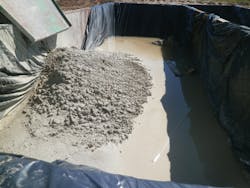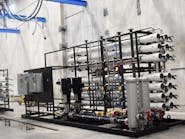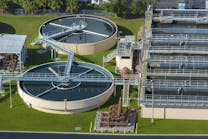Identifying Groundwater Resources and Well Designs to Meet Water Supply Needs
By Frank Getchell
It can be challenging for industrial companies to recognize potential water supply risks before a problem arises. But left vulnerable, companies risk significant and sustained revenue loss should an unforeseen reduction of the water supply occur.
Fortunately, it’s often possible to get ahead of these types of situations. By identifying risks and sustainable alternate or supplemental water supply opportunities early, industrial clients can be proactive rather than reactive.
Most freshwater supplies rely upon replenishment from precipitation, either as direct capture across the surface-water body exposure, or as infiltration through soil and rock into the underlying aquifers. Climate change patterns have resulted in seasonal and/or quantity variations in precipitation, which in turn are affecting the predictability and reliability of surface water and groundwater resources and supplies.
WSP USA collaborates with and provides assistance to industrial clients, identifying appropriate groundwater resources and well siting/designs applicable to the water-supply demands of a facility. WSP’s hydrogeologists are also able to consider the yield and native quality of nearby aquifers relative to the clients’ needs.
WSP recently worked with two forward-thinking clients to develop plans that led to actions that have significantly reduced water supply risks at their facilities.
A deep supply well was designed, installed, tested and permitted under the direction and coordination of WSP for a large data center in S.C. ©2014 WSP USA
Example 1: Manufacturing Facility
A major food products company in central Illinois was looking for an alternate/backup water supply for its facility that operates 24/7 to produce corn sweetener. The facility requires about 3 million gallons per day (MGD) of water to maintain its production schedule and typically relies upon the municipal surface water supply, with some augmentation from the facility’s groundwater supply wells.
Recent changes in climate-driven precipitation patterns have significantly impacted the reliability of the municipal surface-water supply. As a non-potable demand, the facility has been significantly curtailed in its use of this supply several times in recent years in response to prolonged droughts, resulting in adverse economic impacts to the company.
The food products company sought assistance from WSP to identify and develop an alternate water supply that could maintain the necessary 3 MGD from the groundwater resources occurring near the local surface-water supply lake. This would need to be a water supply that shared similar recharge capacities but was hydraulically isolated.
WSP evaluated the potential for using a shallow glacial sand aquifer as a backup plant water supply. Given the small size of the property and its proximity to a nearby lake, radial collector wells were identified as the best alternative for meeting the client’s needs. The firm provided technical services related to the bidding, design, construction oversight and yield/performance testing of two 3.5 MGD collector wells.
The conducted work included provision of hydrogeological consulting services necessary for generation of a bid specification, and technical assistance and prospective contractor interfacing during the bid process. WSP also provided supplemental oversight during exploration drilling and design data collection, along with provision of peer review input regarding the final collector well design and construction activities.
WSP evaluated the potential for using a shallow glacial sand aquifer as a backup plant water supply for a S.C. data center.
©2014 WSP USA
Following the completion of the respective collector wells in late 2013, WSP staff provided peer review opinions regarding the performance and long‐term yield estimates provided by the contractor. The successful installation has given the company and facility management the peace of mind that production could continue at times when drought or other climate conditions deplete the local water supply.
Without this backup system in place, the facility could face significant revenue losses and customer frustration if its production of fructose could not be relied upon year-round.
Example 2: Data Center
The risk of interruption or cessation of operations due to not having an alternative water supply is primarily economic, although in the case of a client in the South Carolina Coastal Plain, it could have an adverse impact on local and regional digital communications as well.
The large data center facility provides communications and data storage capabilities that are used for personal and public operational and security needs. If inoperable, or partially operable, the parties that depend upon this center could face significant communications disruptions.
The data center facility relies upon non-contact water for cooling its infrastructure. The existing municipal supplies were not accessible at the time of construction and were not expected to be for several more years, so an alternative backup solution was sought. As such, development of an on-site groundwater supply from the local aquifer system was identified as a possible solution.
Unfortunately, this plan faced a major hurdle. Portions of the aquifer system, which is several thousand feet thick and consists of several hydraulically separated aquifers, was believed to be prone to local overdevelopment and impact by significant droughts.
WSP conducted a desktop study that included the use of regional groundwater flow models to identify which aquifers might be least potentially impacted by overdevelopment and drought, and would be capable of supporting the facility’s needs without causing significant impacts to existing groundwater supplies in the area.
Once the municipal supply becomes accessible, the S.C. data center facility will use a combination of on-site groundwater and off-site municipal water for its cooling needs. ©2014 WSP USA
Thus, a deep supply well was designed, installed, tested and permitted under the direction and coordination of WSP. Once the local municipal supply becomes accessible, the facility can consider using a combination of on-site groundwater and off-site municipal water for its cooling needs.
Education Is Key
While industrial leaders understand both value of water to their successful operations and the importance of preparing for the unexpected, finding a solution that meets the specific needs and conditions of an individual facility is essential. What works for one site may be ineffective for another.
Educating industrial clients during the proposal and initial project stages about how groundwater and wells “work” and the natural variability inherent in the reliability of the related supplies is an important part of the process, as are developing trust with regulators and other stakeholders, and recognizing the importance of understanding project needs and buy-in.
As part of this education process, explanations of climate-change impacts on precipitation and the long-term performance and maintenance of wells need to be discussed, as well as the need to address appropriate regulatory concerns and water quality impacts.
While techniques to locate these resources are not new, we now have the benefit of technology that removes the guesswork from the recommended solutions. With computer modeling of groundwater flow, geographic information system (GIS)-developed presentations, and computer-generated illustrations, hydrogeologists can identify reliable alternate water supplies and present their findings in a way that helps with the decision-making process.
Through face-to-face discussions during project formulation meetings, detailed proposal structures, and with computer-generated graphics and data presentations, we can identify and present these concerns so that clients understand the risks they face, the consequences of inaction, and the potential solutions available to them. IWW
About the Author: Frank Getchell, P.G., is a senior supervising hydrogeologist in the Upper Saddle River, N.J., office of WSP USA.
Circle No. 140 on Reader Service Card




